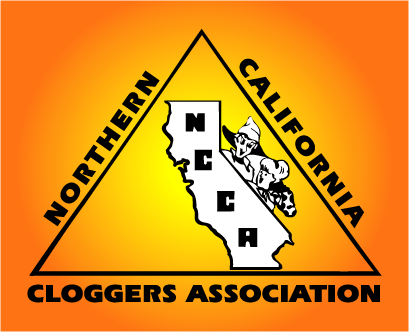Northern California
Cloggers Association, Inc.
For Information on Clogging in Northern California
WHAT IS
CLOGGING?
WHAT IS CLOGGING?
Clogging, or clog dancing, is a lively dance with roots in Irish jig, English country dances, Scottish dances, African steps and rhythms and possibly even a bit of Cherokee Indian. It is a percussive dance, meaning the dancers beat out rhythms with their feet. Settlers brought their own dances and music to the Southern Appalachian Mountain area, where they were relatively isolated from other parts of the country. These steps and styles mixed together into what we now call clogging.
Characteristic of clogging is the rhythmic beat that the dancers’ feet are continually making. Traditional clogging involves fewer than ten basic movements, but these combine to make quite a variety of steps. New steps and styles from other dances are often icorporated into traditional clogging steps to make even more variety in contemporary clogging.
Originally a solo dance, it was considered rude if you showed off, or did your steps while dancing with a partner. Eventually, however, clogging became a part of Appalachian Big Circle Dancing, which is a relative of modern square dancing. Square dances in the Appalachians can still include people clogging while executing the simple figures of Big Circle Dancing called by a caller. Although each dancer may be doing different steps, they all keep the same rhythm and a hall full of cloggers can be quite impressive.
Traditional clogging was danced to banjos, fiddles or whatever the settlers had to bang or twang to make a lively tune. A dancer would improvise or show off his/her favorite steps. Each dancer and each area had a distinctive style. Eventually, these styles blended together to create what is now called clogging.
Clogging is related to tap dancing, but has a different style. Cloggers have a distinctive up and down body motion and emphasize the downbeat of the music. There is also a distinctive “chicka-boom” sound that cloggers make. Tap dancers tend to be lighter and tap out the melody, rather than the beat. Most cloggers today do wear taps, usually the 2-piece kind. to emphasize the sounds of the feet.
Modern cloggers often do precision clogging, which means that all the dancers are doing the same step at the same time. This can be in choreographed routines (often written to perform in front of an audience), or in recreational style line dances. Clogging line dances have become the most popular form of clogging these days. Workshops and convention often include teachers introducing new line dances and a floor can have 100 or more dancers all doing the same steps. It’s something to watch!
Today cloggers dance to many styles of music, but always music with a lively beat. Bluegrass music is the traditional music of clogging, but you’ll find country, pop, and hip hop used just as often these days. Line dances are the most popular style of dance in many areas, but clogging can be done solo, in couples, small groups, or large groups. Freestyling, or hoedowning is where each individual dancer is doing his or her own thing, executing steps as they come to mind. Precision clogging refers to two or more dancers executing the same steps at the same time. Cued dances are a popular form of recreational clogging where the sequence is cued to the dancers. The dancers are familiar with the steps, but they don’t have to memorize the entire dance sequence. This way dancers can enjoy many more dances than if each one were memorized.
Many groups also spend additional time to learn precision clogging routines to perform. These may include fancy steps sequences as well as the dancers going through figures and different patterns with each other. Usually the dancers will all wear the same costume as well.
There are also clogging competitions in some areas of the country, however, not in Northern California. Categories can include a cappella, line dances, precision routines, traditional routines, show routines (with a theme), and individual freestyling.
Interested in learning more? Contact one of the teachers near you.
Lois Elling
Home / Upcoming Events / Photos / Contact us
rev 7/6/20b
